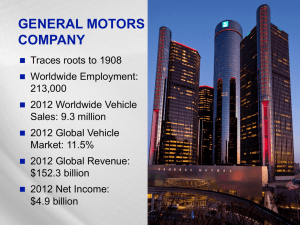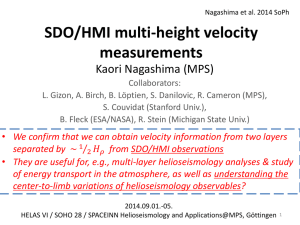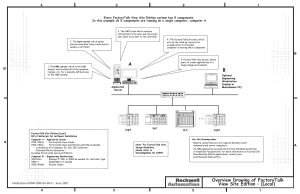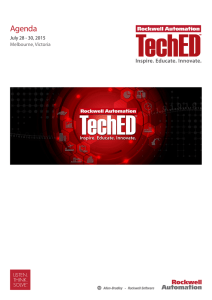Control system quality: - Purdue University Calumet
advertisement
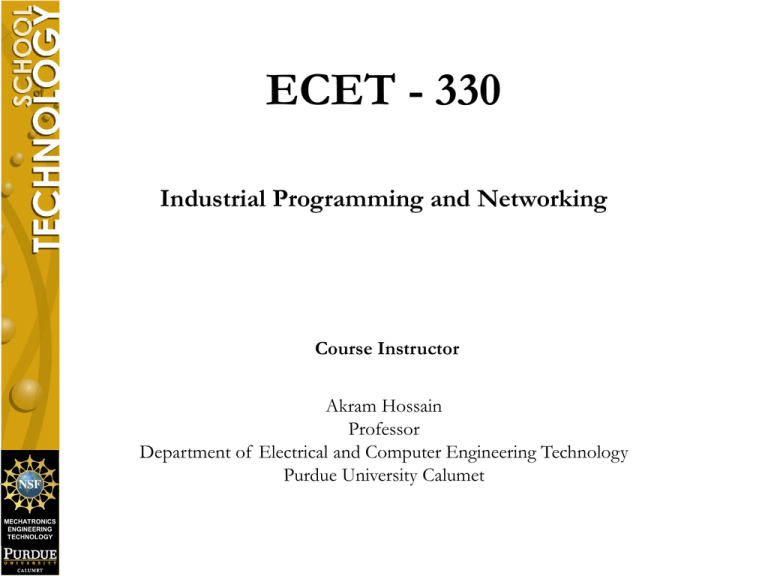
ECET - 330 Industrial Programming and Networking Course Instructor Akram Hossain Professor Department of Electrical and Computer Engineering Technology Purdue University Calumet MECHATRONICS ENGINEERING TECHNOLOGY Human Machine Interface (HMI) MECHATRONICS ENGINEERING TECHNOLOGY What is an HMI ? In automation & process control industry, HMI is the user interface where interaction between the operator and machine occurs. The goal of this interaction is to maximize operating effectiveness, safety, productivity and reduce human errors while controlling both simple and complex industrial machines. An HMI provides a mean of : • Input, allowing the users to manipulate a system. • Output, allowing the system to indicate the effects of the user’s manipulation Types of Industrial HMIs ? MECHATRONICS ENGINEERING TECHNOLOGY Keypad/Touch Screen HMI Touch Only Screen HMI Purpose of an Industrial HMI Unit? In manufacturing and process control industries, an HMI is included as an integral part with the automated machines. The main purpose of an HMI unit is to provide the operator of a system with the ease to detect and understand an event and to respond to the changes efficiently. • Detect- any change in the machine’s operating conditions is usually seen by a change in display or information on an indicator. Different means are used for the operator to be able to detect the changes such as flashing information, color changes, sound signal etc. •Understand- legible instructions and accurate information are provided on the display screen so that the operator is able to easily understand and use those in order to avoid any action that might endanger safety. •Respond- depending on the message shown on the HMI screen, an operator is able to act swiftly by pressing touch buttons or command keys. These buttons/keys has to be clearly marked to be easily indentified and understood by the operator in order to take MECHATRONICS ENGINEERING TECHNOLOGY right actions. Benefits of HMI in Automation Cell • Takes the place of Physical push buttons • Allows the operator to start and stop cycles • Eliminates excessive wiring by interlinking directly into the PLC • Easily reprogrammable to add almost any function that exists currently in the PLC without extra wiring or design changes • Clear customizable HMI status screens for easier troubleshooting and to save on downtime MECHATRONICS ENGINEERING TECHNOLOGY • Alarm control HMI • Monitor part count • Password protection to lock specific people out of performing certain functions • Display PLC numeric data • Upload pictures for clarification and fast recognition • Easy cell duplication • Easy cell operation capability from a central location • HMI can connect to multiple PLC's within the cell for complete cell status • Color coding allows for easy identification (ex. red for trouble green ok) Basic Functionalities of Industrial HMI Unit? HMI units nowadays comprise of almost unlimited functions. However the Basic functions are as following: • Graphic Displays- To provide information about machine operation and status to the operator for easy interpretation determination of need for actions. • User Input- To facilitate inputs from the operator to adjust machine operations, perform machine setups, and respond to events. • Data Logging & Storage- To provide for the storage of historical machine operating data for part traceability and analysis of ways to improve quality, productivity and uptime. • Trending- To provide a means for visual analysis of data on current or past machine operation. • Alarming- To provide notification to the operator of abnormal operating conditions. MECHATRONICS ENGINEERING TECHNOLOGY Programmable Logic Controller (PLC) and HMI Communication Diagram MECHATRONICS ENGINEERING TECHNOLOGY Allen-Bradley FactoryTalk View Machine Edition FactoryTalk® View Machine Edition (ME) is a machine-level HMI software for machines and small processes. FactoryTalk View Machine Edition allows for a consistent operator interface across multiple platforms, including Microsoft® Windows® CE, XP and Vista solutions. FactoryTalk® View Machine Edition consists of two primary modules: • FactoryTalk View Studio: Configuration software for developing and testing HMI applications. • FactoryTalk View ME Station: A traditional "stand-alone" HMI solution that packages a server and client for use on a PanelView Plus, PanelView Plus CE, Rockwell Automation Industrial Computers, or other industrial computer running a supporting Microsoft Windows operation system. MECHATRONICS ENGINEERING TECHNOLOGY FactoryTalk View Studio FactoryTalk View Studio allows users to create applications in a single design environment. FactoryTalk View Studio supports editing and reusing projects for improved portability between embedded machine and supervisory HMI systems. With FactoryTalk View, all software products in the suite are built on the same integrated, scalable architecture. Application developers can import entire machine-level applications into supervisory-level applications or drag individual components and drop them right into supervisory projects, saving development time and reducing engineering and training costs. With FactoryTalk View Studio, one can: 1. Configure a single operator station or configure an entire distributed application from one location 2. Access tags from OPC servers throughout the system via a tag browser that presents direct PLC tags and HMI tags in a logical hierarchy 3. Remotely configure RSLinx and FactoryTalk View Site Edition servers. 4. Create displays using a full-featured graphics editor. MECHATRONICS ENGINEERING TECHNOLOGY HMI Tags A tag is a logical name for a variable in a device or local memory (RAM). For Example, a tag can represent a process variable in a programmable logic controller (PLC). In FactoryTalk View, tags are created by the user in RSLogix500 (Micrologix) or RSLogix 5000 (Compactlogix) PLC programming software and stored in a central tag database. Tags can be imported from controller file to FactoryTalk View and are assigned to different buttons/objects in order to execute various actions from the PLC to the system by touch/press. FactoryTalk Directory provides access to both offline and online tags through a tag browser. • Offline Tags- If a network is not connected to the controller, developers can work with offline tags. When working offline, the system reads data points directly from the processor’s project file defined in RSLinx Enterprise. Developers can build an entire application offline, without connecting to processors, and then deploy the application to a runtime system later. • Online Tags-If a network is connected to the controller, access to online tags is also available. In this case, the system communicates directly with the processor itself and reads MECHATRONICS ENGINEERING TECHNOLOGY data points as they are defined in that processor. HMI Tag Types In FactoryTalk View various types of HMI tags can be created to serve different purposes. • Analog Tags- Store range of values. These tags are used to represent variable states such as the position of a rotary control or temperature. • Digital Tags- Store data with only two states, 0 or 1. They are used to represent devices that can only be “On” or “Off”, such as switches, contacts and relays. • String Tags- Store data with ASCII string, series of characters or whole word (maximum of 82 characters. String tags are used to represent devices that use text, such as bar code scanner that uses as alphanumeric product code. • System Tags- Stores information generated while the system is running, such as the name of the logged-in user, system time and date and so on. •Device tag: An analog, digital or string tag with a device (Node) as its data source. •Memory tag: An analog, digital or string tag with memory as its data source. MECHATRONICS ENGINEERING TECHNOLOGY Linking Objects with HMI tags Double-click the object to open the object’s Properties dialog box, and then click the Connections tab. MECHATRONICS ENGINEERING TECHNOLOGY HMI Push Buttons for Starting and Controlling Process • Momentary push button- Start a process or action by sending one value to the tag when pressed, and another value when released. • Maintained push button- Toggle between two values by sending one value to the tag when pressed, and a second value the next time the button is pressed and released. This button is useful for changing a setting within a machine or process, but not for starting the machine or process. • Latched push button- Start a machine or process. The button remains set (latched) until the process is complete. For example, use this button to start a bag filling machine. When the process is complete (the bag is full), the button is reset (unlatched) by the Handshake connection. • Multistate push button- Cycle through a series of values. Each time the operator presses the button, the value for the next state is sent to the tag. When the button is in its last state, pressing it changes the button to its first state and writes out the first state value. The button displays the current state of an operation by showing a different color, caption, or image to reflect the different states. MECHATRONICS ENGINEERING TECHNOLOGY Continued • Interlocked push button- Use a group of buttons to send values to the same tag. When the operator presses one button in the group, the button’s value is sent to the tag, and the button remains highlighted as long as the tag value is the same as the button’s value. Pressing another button in the group releases the first button, and sends a new value to the tag. • Ramp button- Increase or decrease the value of a tag by a specified integer or floating-point value. For example, use two ramp buttons together to create a raise/lower control. • Control list selector- Select from a list of states for a process or operation. The list is highlighted to show the current state, and the operator can scroll through the list to select a different state. The value assigned to the selected state is written to the tag. • Piloted control list selector- Select from a list of states for a process or operation. The list is highlighted to show the current state, and the operator or a remote device such as a programmable controller can scroll through the list to select a different state. MECHATRONICS ENGINEERING TECHNOLOGY HMI Alarms & Events In FactoryTalk View HMI engineers can create applications that generate alarms and events to notify operators about the status of process activity. • Alarms- An alarm occurs when something goes wrong or is about to go wrong. Alarms are also used to indicate the approach of a dangerous condition. It is often equally important to have a record of the alarm and whether the alarm was acknowledged. • Events-represent normal system status messages. A typical event is when a system condition occurs, such as an operator logging on to an PanelView Plus application. Operators do not have to acknowledge events. FactoryTalk Alarms and Events can support information provided by two different types of alarm sources: • Device-based Alarms -Pre-built alarm instructions that are programmed in a RSLogix500 or RSLogix5000 project and then downloaded into a PLC. The controller detects alarm conditions and publishes event information, which is routed through the system for display and logging. • Tag-based Alarms -Software-based alarm servers monitor data tags for alarm conditions MECHATRONICS ENGINEERING TECHNOLOGY and publish event information for display and logging (Figure 3). Tag based alarm monitoring is supported by Logix controllers, PLC-5 controllers. Continued How Alarms Work HMI engineers specify the tags and expressions (also known as connections) to monitor for alarm conditions by creating an alarm trigger for each connection. Each alarm trigger can generate one or more alarm messages, associated with different trigger connection values. For each alarm trigger, user specify the trigger values that will generate alarm messages, and create the messages to display for the trigger values. The trigger value can be a non-zero integer value or a bit position, depending on which trigger data type one assigns. MECHATRONICS ENGINEERING TECHNOLOGY






